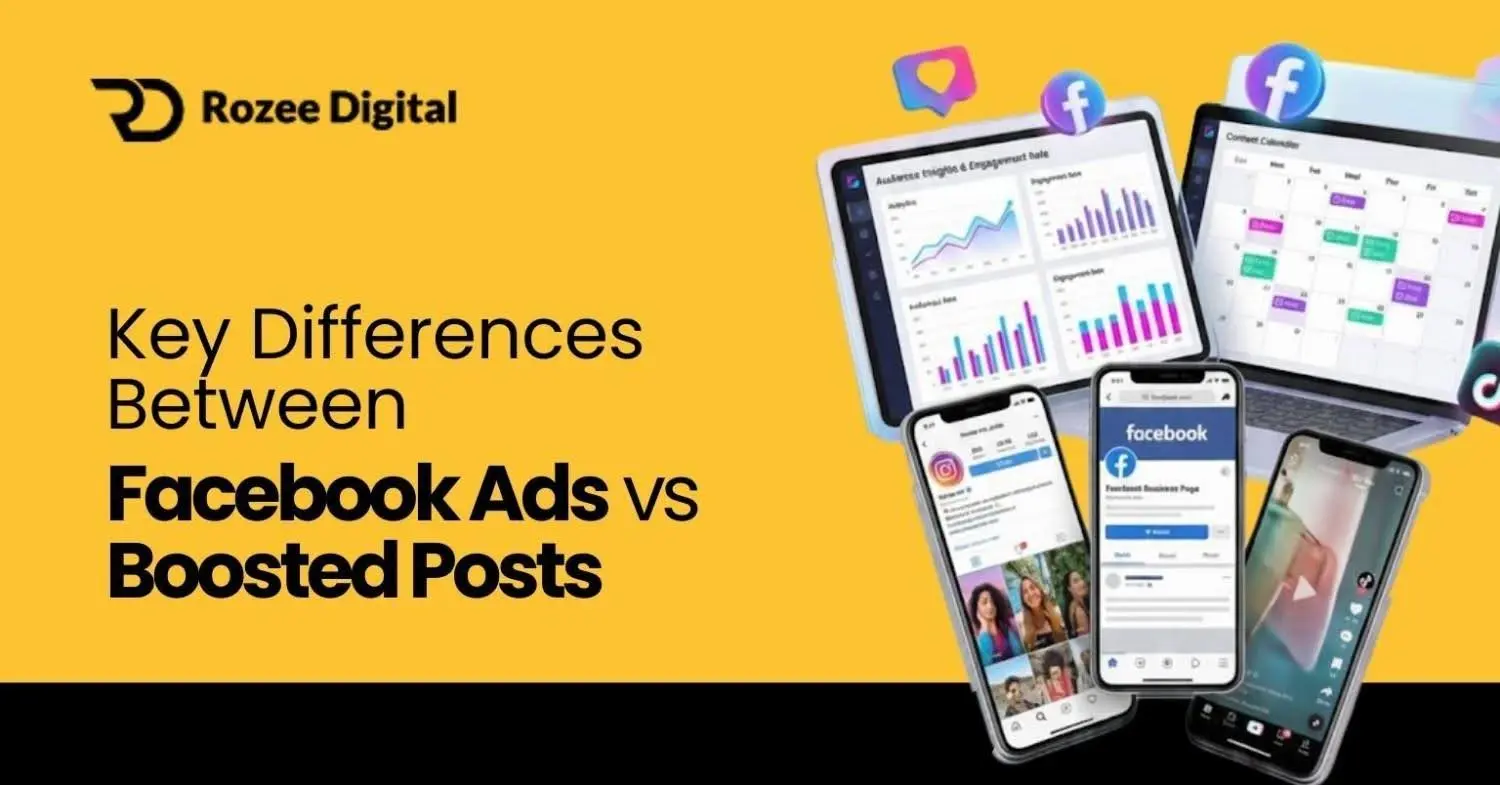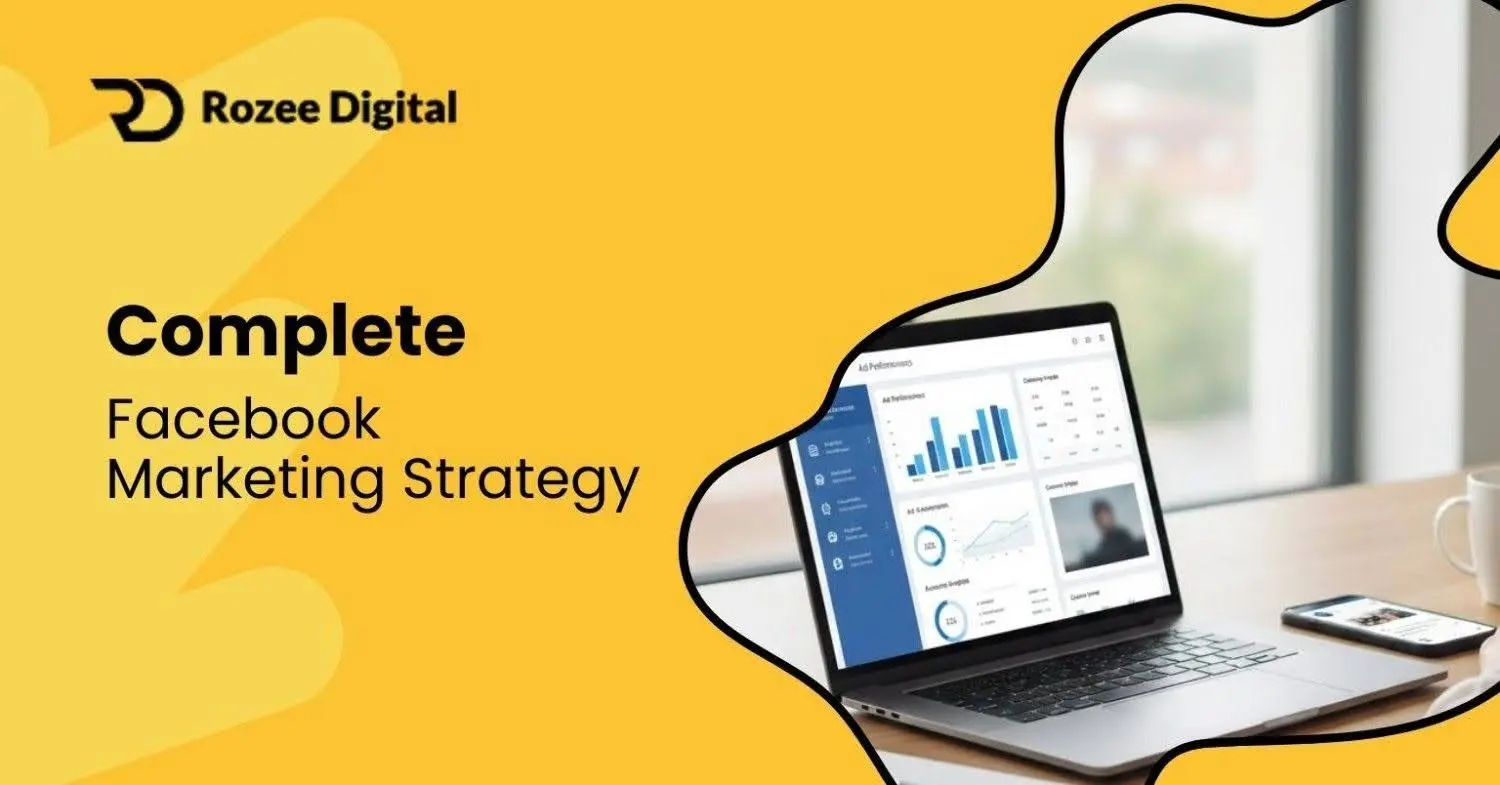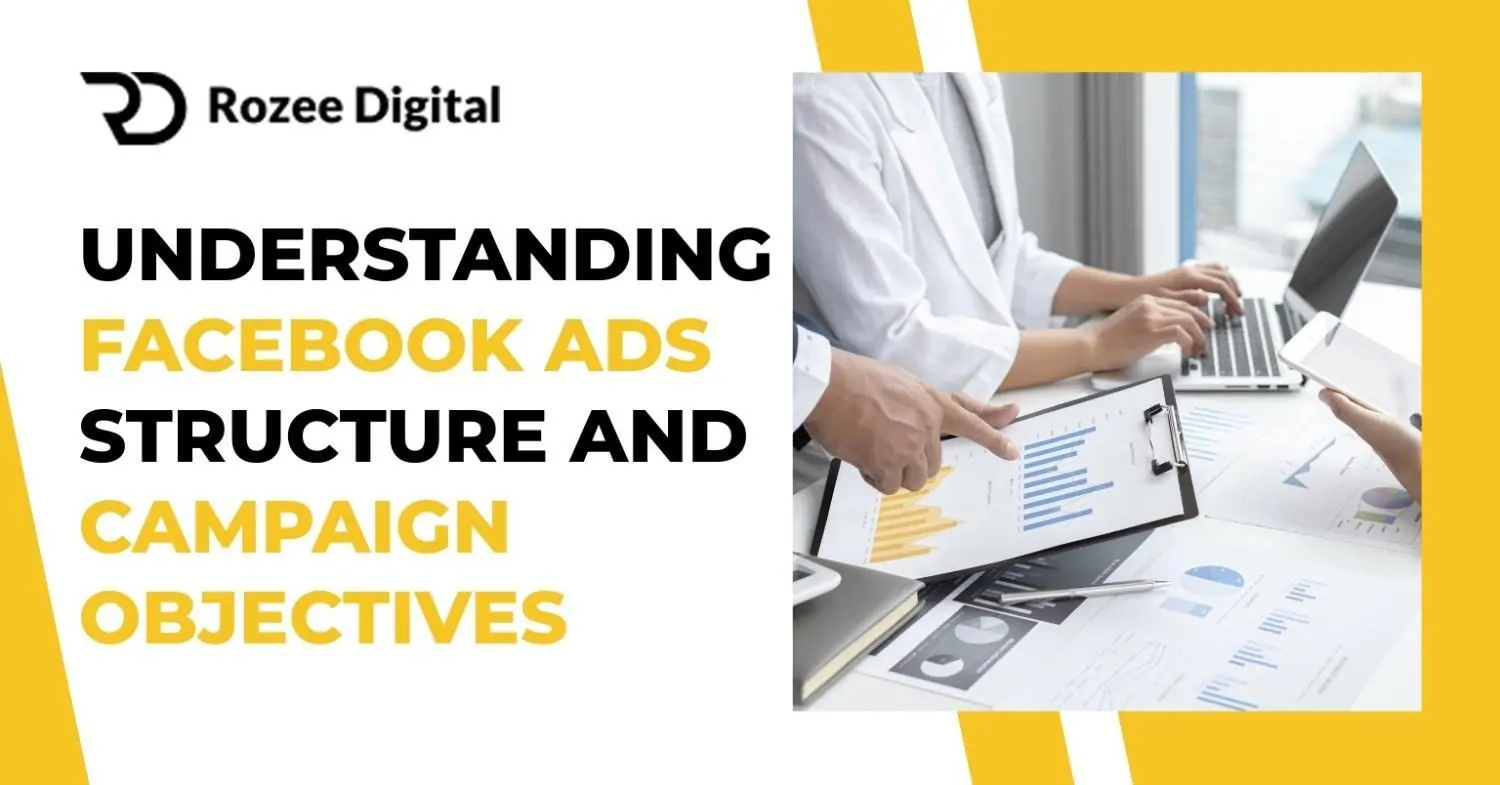Wasting ad budgets on wrong keywords costs businesses millions every year. Poor keyword targeting on advertising campaigns leads to low conversions and high costs. Smart keyword choices can triple your return on investment.
According to WordStream, the average conversion rate across all industries is only 3.75% in 2024. Most campaigns miss their mark because of poor keyword selection. The difference between success and failure often comes down to targeting strategy.
Stop wasting ad budgets and start seeing real results! Contact Rozee Digital today for a free strategy call to optimize your campaigns with smart keyword targeting. Book now or call us directly at +447887880993.
Why Keyword Targeting on Advertising Campaigns Matters More Than Ever
Digital advertising has become more competitive and expensive in 2025. Every dollar must work harder to deliver results. Bad keyword choices drain budgets without delivering sales.
The Real Cost of Poor Keyword Selection
Companies waste money on irrelevant clicks from wrong keywords. These clicks come from broad keywords that attract the wrong audience. Your ad budget disappears fast without bringing actual customers.
Smart keywords targeting Google Ads campaigns can cut costs while improving quality. Precise keywords bring qualified traffic that actually converts. This means more sales from the same budget you already spend.
Most businesses make three critical mistakes with keywords today. They target too broad, ignore search intent, or forget negative keywords. Each mistake multiplies wasted spend and reduces campaign performance dramatically.
The ROI Impact of Strategic Targeting
Campaigns with strategic keyword targeting on advertising campaigns see much better ROI. Businesses using data-driven approaches grow faster than competitors. They focus their budget on proven winners and cut losing keywords quickly.
High-intent keywords convert much better than generic terms. This massive gap impacts profitability directly and immediately. Bottom-funnel keywords drive immediate sales despite lower search volume.
Conversion rates jump dramatically when advertisers match keywords to buyer journey stages. Awareness keywords cost less but convert lower while decision keywords cost more but drive sales. Understanding this difference transforms campaign performance.
Understanding Keyword Match Types for Maximum Control
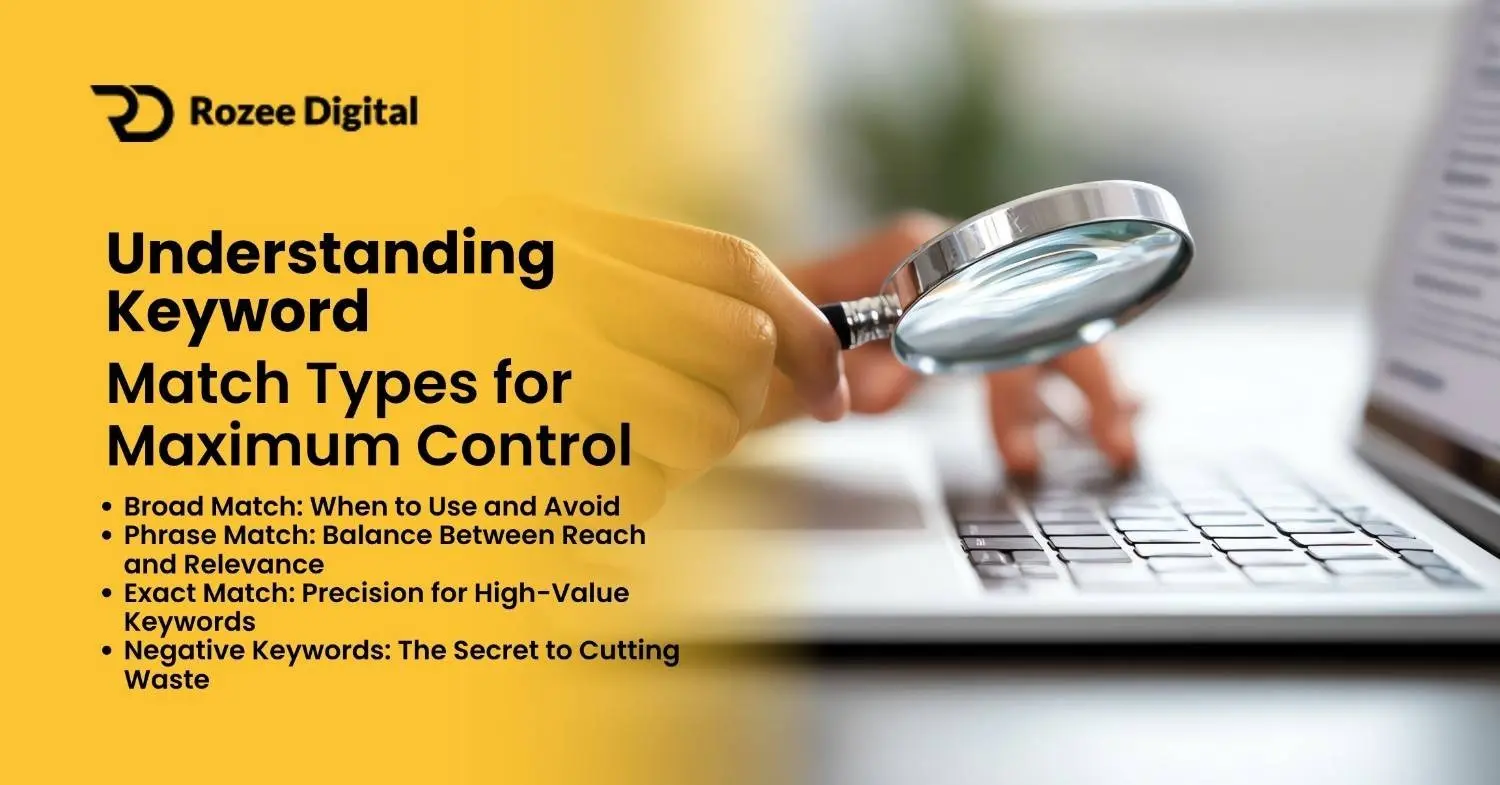
Match types control how closely search queries must match your keywords. Google offers four main types: broad, phrase, exact, and negative. Each serves different campaign goals and budget levels effectively.
- Broad Match: When to Use and Avoid
- Phrase Match: Balance Between Reach and Relevance
- Exact Match: Precision for High-Value Keywords
- Negative Keywords: The Secret to Cutting Waste
Broad Match: When to Use and Avoid
Broad match shows ads for searches related to your keyword meaning. It reaches the widest audience but offers the least control over traffic. Google interprets user intent and shows ads for various search variations.
This match type works well for discovery and brand awareness campaigns. The algorithm finds relevant searches you might miss through manual research. However, broad matches burn the budget fast without proper monitoring and oversight.
Your “running shoes” keyword might trigger ads for “shoe repair” or “shoe stores.” These irrelevant clicks waste money without converting into actual sales. Use broad matches only with negative keyword lists and conversion tracking active.
Set lower bids for broad match keywords compared to exact matches. Monitor search terms reports weekly to add negative keywords regularly. This prevents budget waste while maintaining discovery benefits.
Phrase Match: Balance Between Reach and Relevance
Phrase match shows ads when searches include your keyword phrase meaning. Users can add words before or after your phrase naturally. This offers more control than broad match while maintaining flexibility.
For example, “women’s running shoes” triggers ads for “best women’s running shoes.” It won’t show “running shoes for women” in different word order. This maintains relevance while allowing some search variation.
Phrase match delivers good volume with better conversion rates than broad match. This makes it ideal for most eCommerce campaigns starting out. You get qualified traffic without overpaying for every single click.
Phrase match works perfectly for mid-funnel campaigns targeting consideration stage buyers. These shoppers know what they want but still compare different options. Your ads appear for detailed searches showing purchase intent clearly.
Exact Match: Precision for High-Value Keywords
Exact match shows ads only when search matches your keyword exactly or very close. This includes misspellings, singular/plural forms, and same-meaning searches only. It offers maximum control over your ad spend.
Exact match keywords typically cost more per click than other types. But they convert much better because traffic is highly qualified already. These searchers know exactly what they want to buy right now.
Use exact matches for your best-converting keywords and high-value products. Target bottom-funnel terms like “buy Nike Air Max 90 black size 10.” These specific searches signal ready-to-purchase intent immediately and directly.
Budget a large portion of total spend on exact match keywords that drive actual sales. These keywords might generate less traffic overall but deliver more revenue. Track return on ad spend for each exact match keyword monthly.
Negative Keywords: The Secret to Cutting Waste
Negative keywords prevent ads from showing for irrelevant searches completely. They’re the most overlooked element of targeting ads by keywords strategy effectively. Adding negatives can cut wasted spend significantly overnight.
Campaigns with many negative keywords have much lower cost per acquisition. They block unqualified traffic before it clicks your expensive ads. This improves click-through rates and quality scores automatically.
Common negative keywords for eCommerce include “free,” “cheap,” “DIY,” “used,” and “jobs.” If you sell premium products, add “discount” and “wholesale” too. Review search terms reports every two weeks for new negatives.
Build negative keyword lists by category and apply them across all campaigns. Create lists for non-buyers, competitors, job seekers, and information-only searches today. This systematic approach protects all campaigns simultaneously.
Building Your PPC Keyword Targeting Strategy From Scratch
Strategic keyword research forms the foundation of profitable campaigns overall. Random keyword selection leads to random results and wasted budget. Follow a proven framework to identify winners before spending money.
Step 1: Define Campaign Goals and Buyer Personas
Every successful PPC strategy starts with clear objectives first. Are you building brand awareness or driving immediate sales today? Different goals require different keyword types and match type strategies.
Create detailed buyer personas including demographics, pain points, and search behaviors. A 35-year-old mom shops differently than a 22-year-old college student. Their search terms reveal different needs and purchase intentions clearly.
Map keywords to each stage of your sales funnel systematically. Awareness keywords attract new audiences while consideration keywords help comparison shoppers. Decision keywords capture ready buyers at the bottom of the funnel.
Assign budget percentages based on funnel stage and conversion potential. This ensures you capture demand at every customer journey phase effectively. Higher budgets should go to keywords closer to purchase decisions.
Step 2: Conduct Competitor Keyword Analysis
Your competitors already tested thousands of keywords with real ad spend. Analyze their keyword targeting on advertising campaigns to find proven winners. This shortcut saves time and reduces your risk significantly.
Use tools like SEMrush, SpyFu, or Ahrefs to see competitor keywords. Look for keywords they bid on consistently over many months. Long-term bidding indicates profitability and positive ROI for those specific terms.
You can outbid competitors on their own terms or find gaps they miss. Both approaches work well depending on your budget and goals. Focus on medium-competition keywords where you can compete without overpaying immediately.
Identify 3-5 direct competitors and export their paid keywords for analysis. Filter by search volume and estimated cost per click ranges. This reveals opportunities they’re investing in month after month.
Step 3: Use Keyword Research Tools Strategically
Google Keyword Planner remains the gold standard for keyword targeting Google Ads campaigns. It shows actual search volumes, competition levels, and bid estimates accurately. Use it to validate keyword ideas and forecast realistic budgets.
Start with seed keywords related to your products or services offered. Expand using the tool’s suggestions to find related terms systematically. Look for keywords with decent monthly searches and medium competition levels.
The tool reveals search terms you’d never guess through brainstorming alone. These hidden gems often convert best because competitors miss them. Combine Google Keyword Planner with Amazon autocomplete and Google autocomplete too.
Amazon and Google autocomplete show real customer search patterns daily. If people search these terms on Amazon, they have buying intent. This reveals actual customer language instead of industry jargon.
Step 4: Organize Keywords by Intent and Theme
Group similar keywords into tightly themed ad groups with limited keywords each. Tight themes improve quality scores and ad relevance dramatically over time. This lowers costs while improving your ad position naturally.
Create ad groups based on product categories, buyer intent, or customer problems. An ad group for “women’s running shoes” should only contain variations of that exact theme. Don’t mix running shoes with training shoes or other categories.
Intent-based organization outperforms product-based structure for many eCommerce campaigns. Create separate ad groups for “buy,” “review,” “vs,” and “best” keywords. Each intent type needs different ad copy and landing pages.
Label ad groups clearly with descriptive names that show intent level. Use prefixes like “BTM” for bottom-funnel or “TOP” for awareness keywords. This makes campaign management and optimization much easier long-term.
Advanced Keyword Optimization Techniques That Work
Basic keyword selection gets you started but advanced optimization separates winners from losers. These techniques require more effort but deliver exponentially better results overall. Most competitors skip these steps completely.
Dynamic Keyword Insertion for Higher Relevance
Dynamic keyword insertion automatically adds the user’s search term into your ad headline. This creates highly relevant ads that match exactly what people searched for. Relevance directly impacts click-through rates and conversions dramatically.
People click ads that mirror their exact search query immediately. This simple technique improves quality scores and lowers your cost per click. Use dynamic insertion carefully with phrases and exact match keywords only.
Broad matches can insert awkward or too-long keyword combinations that don’t work. Set a default keyword in case the dynamic insertion doesn’t fit character limits. Test dynamic insertion against static headlines to measure actual impact.
For some products and audiences, static headlines with clear benefits outperform dynamic variations. Always let data guide your decisions instead of assumptions. Run tests for at least two weeks before making final decisions.
Geographic and Demographic Keyword Layering
Add location and demographic modifiers to keywords for hyper-targeted campaigns. “Running shoes Chicago” targets local buyers differently than generic “running shoes” searches. These specific terms often cost less with higher intent signals.
Demographic layering adjusts bids based on age, gender, household income, and parental status. Luxury items perform better with high-income targeting while budget items work best with different demographics. Match your product to the right audience.
Create separate campaigns for different geographic regions with localized keywords naturally. “Winter jackets Toronto” clearly needs different messaging than “winter jackets Miami” clearly. Weather, culture, and local events all influence buyer behavior significantly.
Test demographic bid adjustments in small increments starting conservatively. Monitor performance for two weeks before making larger adjustments to budgets. Some demographics might convert at much higher rates than others.
Seasonal Keyword Planning and Budget Allocation
Seasonal keywords drive massive spikes in search volume and sales at specific times. “Halloween costumes” peaks in October while “tax software” peaks in March-April. Planning ahead captures this demand profitably.
Early birds who bid before the rush get lower cost per clicks. Waiting until peak season means higher costs and intense competition. Create seasonal campaign calendars mapping keywords to months and events.
Allocate more budget to peak season months when demand surges. Build keyword lists and ads several months before each season starts. This preparation ensures you’re ready when customers start searching.
Scale budgets gradually as seasonal demand increases to maintain efficient spending. Don’t max out budgets on day one of the season. Increase daily budgets slowly as search volume grows week by week.
Long-Tail Keywords for Niche Domination
Long-tail keywords are specific phrases with lower search volume but higher conversion intent. “Women’s waterproof trail running shoes size 8” converts better than just “running shoes.” Specificity signals readiness to buy immediately.
These keywords typically cost much less than short-tail competitors in your industry. Most advertisers ignore them and miss huge profit opportunities. Long-tail keywords work perfectly for niche products and specific customer segments.
If you sell vegan protein powder, target “organic pea protein powder vanilla” specifically. Don’t just target “protein powder” and hope for the best. You’ll reach exactly the right buyers ready to purchase.
Build lists of many long-tail variations for each main product category. Use customer reviews, support questions, and search query reports as sources. Real customer language converts better than industry jargon every time.
Keyword Performance Tracking and Optimization Framework
Setting up campaigns is just the beginning of effective keyword targeting on advertising campaigns. Continuous monitoring and optimization separate profitable campaigns from money pits. Use this framework to improve performance systematically.
Essential Metrics to Monitor Weekly
Click-through rate shows how relevant your keywords and ads are to searches. Keywords with low click-through rates need better ads or should be paused. This metric reveals whether your targeting matches user intent well.
Cost per click directly impacts profitability and campaign efficiency overall. Track actual cost per click versus your maximum bid to identify overpaying. Keywords consistently at max bid indicate high competition requiring strategic decisions.
Conversion rate reveals which keywords drive actual business results, not just clicks. Keywords with high conversion rates are starting to scale aggressively. Focus budget and attention on keywords that actually drive revenue.
Return on ad spend is the ultimate measure of keyword profitability. Calculate revenue divided by ad spend for each keyword monthly. Top keywords should deliver strong returns depending on your product margins.
The 30-60-90 Day Optimization Cycle
The first 30 days focus on data collection and identifying clear losers quickly. Pause keywords with zero conversions after many clicks or very high costs. Keep everything else running to gather statistically significant data.
Patient testing beats reactive changes every single time in paid advertising. Campaigns need time and conversion data before optimization algorithms work effectively. Rush decisions waste money testing repeatedly without learning anything.
Days 31-60 involve scaling winners and testing bid adjustments on marginal keywords. Increase budgets on high-return keywords that prove themselves. Test bid adjustments on keywords with moderate conversion numbers.
Days 61-90 focus on expansion through keyword variations and new match types. Add negative keywords weekly based on search terms reports consistently. Launch tests of new keyword themes in separate campaigns.
Search Terms Report Analysis for Hidden Gems
Search terms reports show actual queries that triggered your paid ads. This reveals new keyword opportunities and wasteful spending clearly. Review this report at least twice monthly for campaign health.
Look for high-converting search terms not in your keyword lists yet. Add these as exact or phrase match keywords immediately. They’re proven winners generating results already at potentially higher costs.
These hidden opportunities come from broad and phrase match discovery. They represent free market research from actual customer searches. Identify irrelevant search terms burning budget and add them as negatives.
Terms with many clicks and zero conversions are clear losers. Block them to redirect spend toward better-performing keywords. This continuous refinement improves campaign efficiency month over month.
Common Keyword Targeting Mistakes Costing You Money
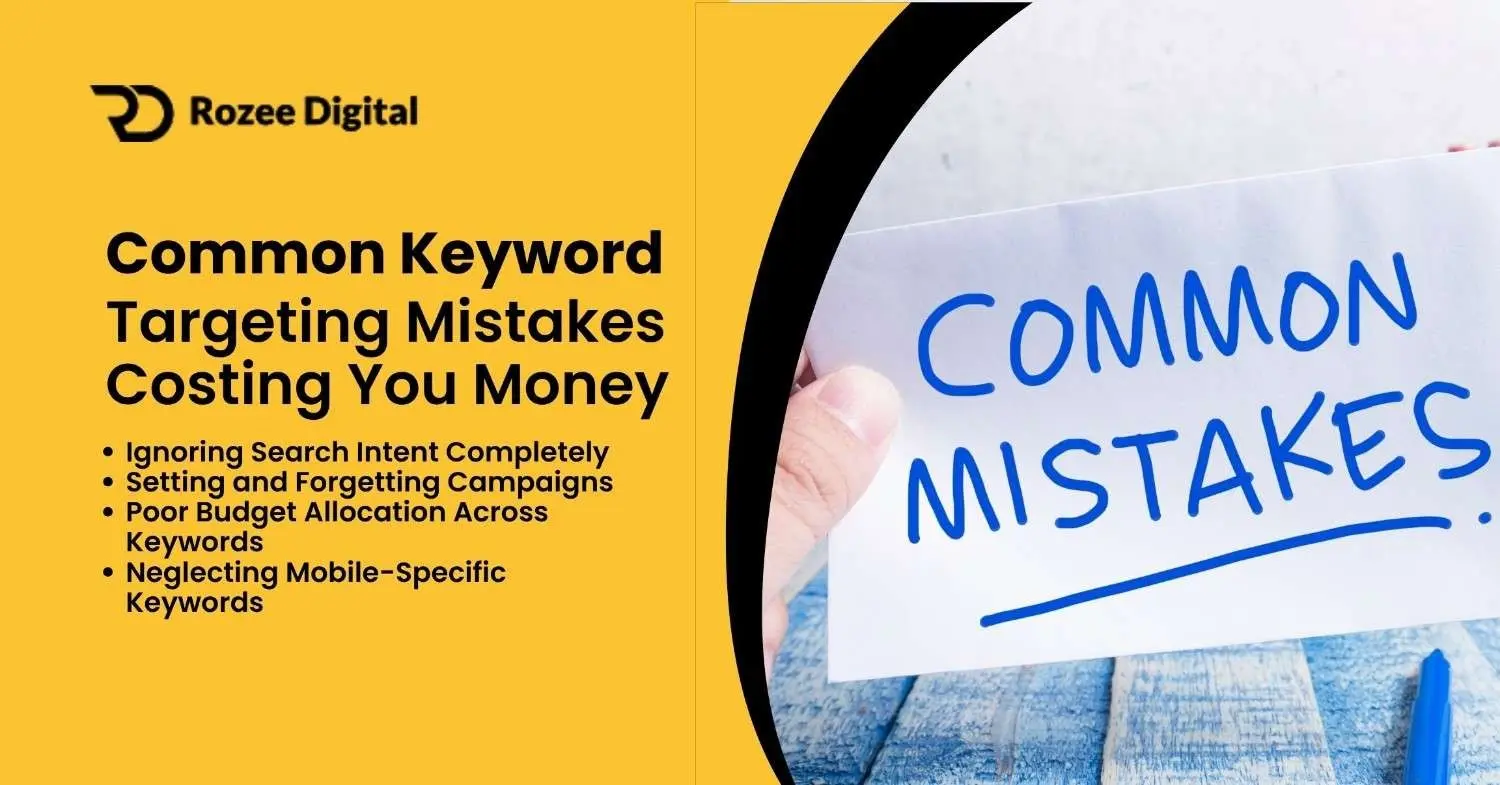
Even experienced marketers make costly keyword mistakes that drain budgets. Recognizing these pitfalls helps you avoid them and maintain profitable campaigns. Here are the biggest mistakes we see repeatedly.
- Ignoring Search Intent Completely
- Setting and Forgetting Campaigns
- Poor Budget Allocation Across Keywords
- Neglecting Mobile-Specific Keywords
Mistake 1: Ignoring Search Intent Completely
Search intent determines whether a keyword will convert not just search volume. “Running shoes” might be research while “buy Nike Pegasus 40” is purchase intent. Mixing intent types in one campaign causes serious performance issues.
Many advertisers chase high-volume keywords without considering user goals at all. Someone searching “how to tie running shoes” won’t buy today. They need information not products right now.
Categorize every keyword by intent: informational, navigational, commercial, or transactional clearly. Build separate campaigns for each intent type with appropriate budgets. Use different landing pages and ad copy matching user goals.
Send informational searches to blog posts not product pages directly. Send transactional searches to purchase pages and checkout. This alignment dramatically improves conversion rates and reduces wasted spend.
Mistake 2: Setting and Forgetting Campaigns
Paid advertising requires active management not passive observation only. Market conditions, competition, and customer behavior change constantly. Static campaigns decline in performance quickly without regular optimization.
Most failing campaigns receive very little management time per month. Successful campaigns require regular optimization sessions minimum. Time investment directly correlates with return on investment improvements.
Competition increases in most industries meaning costs rise over time naturally. Keywords profitable last quarter might lose money today. Regular monitoring catches problems before they drain a significant budget unnecessarily.
Schedule weekly optimization sessions focusing on one metric each week. This systematic approach ensures nothing gets ignored. Consistency compounds results over time into major improvements.
Mistake 3: Poor Budget Allocation Across Keywords
Many advertisers split budgets equally across all keywords treating them the same. This ignores performance differences and leaves money on the table. Top keywords typically drive most results in campaigns.
Under-funding high-performing keywords caps potential revenue arbitrarily and unnecessarily. If a keyword delivers strong returns, increase budget until returns diminish. Don’t let artificial budget limits restrict growth opportunities.
Review keyword-level performance monthly and reallocate budgets accordingly. Shift budget from poor performers to proven winners. This continuous rebalancing maximizes overall campaign profitability significantly.
Focus budget on keywords closest to purchase decisions. These bottom-funnel terms deliver immediate returns and revenue. Scale them aggressively while they remain profitable.
Mistake 4: Neglecting Mobile-Specific Keywords
Mobile searches now account for most Google searches globally today. Mobile user behavior differs significantly from desktop requiring adjusted keyword strategies. Ignoring mobile means missing the majority of potential customers.
Mobile shoppers use shorter, more conversational keywords in their searches. They search for “pizza near me” not “pizza restaurants in downtown Chicago.” Create mobile-specific campaigns with appropriate bid adjustments.
Use location extensions and click-to-call buttons for mobile ads specifically. These features significantly improve mobile conversion rates. Test mobile landing pages separately ensuring fast load times.
Mobile users abandon slow sites immediately wasting your ad spend. Page speed directly impacts mobile conversion rates and quality scores. Optimize mobile experience to maximize returns from mobile traffic.
Industry Benchmarks: How Your Keywords Should Perform
https://drive.google.com/file/d/1ZeM3i4tOT1YknYxS1NrML1kQXwabIx8w/view?usp=sharing
Benchmarks provide context for evaluating keyword performance objectively. Without standards, you can’t tell if results are good or terrible. Use these benchmarks to guide targeting ads by keywords decisions.
Conversion Rate Benchmarks by Industry
| Industry | Average Conversion Rate | Top Performers |
| eCommerce | 2.77% | 5-8% |
| Fashion/Apparel | 2.3% | 4-6% |
| Health & Beauty | 3.2% | 6-9% |
| Home Goods | 2.1% | 4-7% |
| Electronics | 1.8% | 3-5% |
| Sports/Outdoors | 2.6% | 5-8% |
Industry benchmarks show massive variation by sector and keyword intent. Top performers typically run much higher than industry average conversion rates. This difference separates profitable businesses from struggling competitors clearly.
Your conversion rates depend heavily on product price points and complexity. High-ticket items naturally convert lower than impulse purchases. A laptop converts differently than a phone case.
Track your historical performance as your primary benchmark, not just industry averages. Focus on beating your own records quarter over quarter consistently. Small improvements each quarter compound to exponential growth annually.
Quality Score and Its Impact on Costs
Quality Score rates your keywords from 1-10 based on relevance and landing page experience. Quality Score significantly impacts cost per click and ad position. Higher scores mean lower costs and better placement.
Keywords with high Quality Scores can cost much less than low-score keywords for the same position. This difference compounds over months into massive savings. Improving Quality Score should be a top priority.
Expected click-through rate contributes most heavily to Quality Score calculation. Write a compelling ad copy that matches keyword intent exactly. Use keywords in headlines and descriptions naturally.
Landing page experience also impacts Quality Score significantly. Ensure landing pages load fast, provide relevant content, and offer smooth mobile experiences. These technical factors directly affect your advertising costs.
Key Takeaways: Build Your Winning Keyword Strategy Today
Successful keyword targeting on advertising campaigns requires strategic planning and continuous optimization. Follow these concrete steps to build campaigns that consistently deliver positive returns. Start implementing these changes this week.
Start with intent-based keyword research mapping to your sales funnel. Categorize every keyword as awareness, consideration, or decision-stage. Allocate budgets accordingly with focus toward bottom-funnel terms. This ensures you capture buyers ready to purchase.
Implement all four match types strategically with different bid levels. Use exact match for proven winners at highest bids. Deploy phrase match for scaling with mid-level bids. Test broad match with lowest bids and tight negative lists.
Create tightly themed ad groups with limited keywords maximum each. Group keywords by product category and intent type. Write multiple ad variations per group testing different value propositions. Let Google’s algorithms optimize toward best performers automatically.
Establish weekly optimization routines focusing on one metric each session. Review search terms and add negatives regularly. Analyze conversions and scale winners. Adjust bids based on performance data. Test new keyword themes.
Track performance against your own historical benchmarks and margins. Don’t obsess over industry averages that might not apply to you. Focus on beating last quarter’s metrics consistently. Calculate maximum acceptable costs based on your actual product margins.
Test long-tail keyword variations that competitors ignore completely. These specific searches convert at much higher rates despite lower volume. Build lists of long-tail terms per product category. They deliver quick wins with less competition.
Ready to transform your ad campaigns with data-driven keyword strategies? Contact Rozee Digital today for a free strategy call and see how our team builds high-ROI PPC campaigns for eCommerce brands. We use advanced keyword research and continuous optimization to maximize your advertising returns. Book now or call us directly at +447887880993 to unlock your campaign’s full potential.
FAQs
Q.1: What is keyword targeting on advertising campaigns?
Keyword targeting on advertising campaigns means selecting specific search terms to trigger your ads. It connects your products with people actively searching for them. Good targeting increases sales while reducing wasted ad spend.
Q.2: How many keywords should I target per campaign?
Start with 20-50 keywords per campaign organized into tightly themed ad groups. Each ad group should contain 10-20 closely related keywords maximum. This structure improves relevance and Quality Scores.
Q.3: What’s the difference between keyword match types?
Broad match shows ads for related searches with maximum reach. Phrase match requires your keyword phrase in the search query. Exact match shows ads only for your specific keyword.
Q.4: How often should I add negative keywords?
Review search terms reports and add negative keywords at least twice monthly. Active campaigns need weekly negative keyword updates to prevent waste. Build master negative lists applied across all campaigns.
Q.5: What’s a good conversion rate for Google Ads?
Average eCommerce conversion rates range from 2-3% with top performers achieving 5-8%. Your target depends on industry, product price, and profit margins. Focus on improving your own rates.


